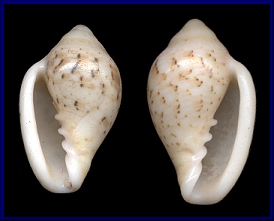| Southern Hemisphere Sinistrals |
| By Mariette Jearey |
| Since sinistral coiling has been a hot topic in the Shell-O-Gram and you keep a record of various sinistral species, I thought I'd let you know about a recent find of mine. According to Markus Lussi, it is a cross between a typical Volvarina zonata (Kiener, 1841) and V. zonata form cleo Bartsch, 1915, and it is a beautiful live sinistral specimen of golden orange color with a deeper orange spiral band (grade F++). Suffice it to say that I made enough joyous noise on the rocks upon discovery to scare the nearby fisherman motherless. This is the fifth sinistral shell that I have personally found. I believe that it is pretty unusual to find one sinistral shell, let alone five (two Cypraeaovula capensis (Gray, 1828), two Marginella lutea G. B. Sowerby II, 1889, and now this Volvarina)! |
|
|
|
Marginella lutea (19.6 mm.) - Beach at Jeffreys Bay, South Africa [H. G. Lee Collection] |
| I have seen one other
sinistral Volvarina, V. zonata
form bilineata (Krauss,
1848), at Brian Hayes’ before.*
It was from an old collection that he had
bought. It was in a bag with about 20 dextrals of its form. It
appears as though the collector was not even aware of the fact
that the one shell was sinistral. I've been collecting marine shells for about eleven years now. In the beginning I was so dense that I thought the blotches on C. capensis were the result of oil/tar spillage on the beach (Cape Recife, Southern point of Algoa Bay) where I picked them up. Being typically female, I tried very hard to remove the offensive blotches.(Laugh all you want). Once I realized that the blotch was species-specific, I put all my C. capensis, dorsum up, in a row in front of me. There was this one crazy shell that would not fit - no matter how I turned it. Voilą, my first sinistral shell. Of course, at the time, I did not realize just how rare and special they are; all I knew was that there was something wrong with it. Five years later, after many miles of walking and many "dry" months of shelling, wouldn’t you know it, another "Voilą!" The only shell on the beach! I bet that any person watching me at the time would have thought me certifiable. Singing a raunchy "Alleluja" comes to memory. Subsequently I have sold both those shells, the first (for a fraction of its real value) so I could buy my own SCUBA tank, the second to help finance my recent trip to America and the Bahamas. Later in that same year (June, 1991) I found a sinistral Marginella lutea on the beach at Jeffreys Bay and another year later, a second one, which was so coveted by a Marginella-collector friend, even though it had a missing protoconch, that I gave the shell to him. So, to date I have only the two sinistral shells left: Marginella lutea and my latest find, the Volvarina zonata form cleo. It seems to me that sinistral shells are elusive until you've discovered your first. After that, if it is "anomalously reverse-coiled" and it is in front of you, however rare the occasion, you WILL notice it. That is my story. I'm doubtful that this will elevate me to the status of "super-sheller" since I am still an absolute lay person when it comes to the science of conchology. I still have a lot to learn. I do know this: I love the sea, I love shells, I love diving, I love the people that I've met through the shells. Since love is the only thing that can be divided without being diminished, I believe I have tapped a lot of love from this hobby and the container is still full. *Brian Hayes is a South African collector/dealer. |
